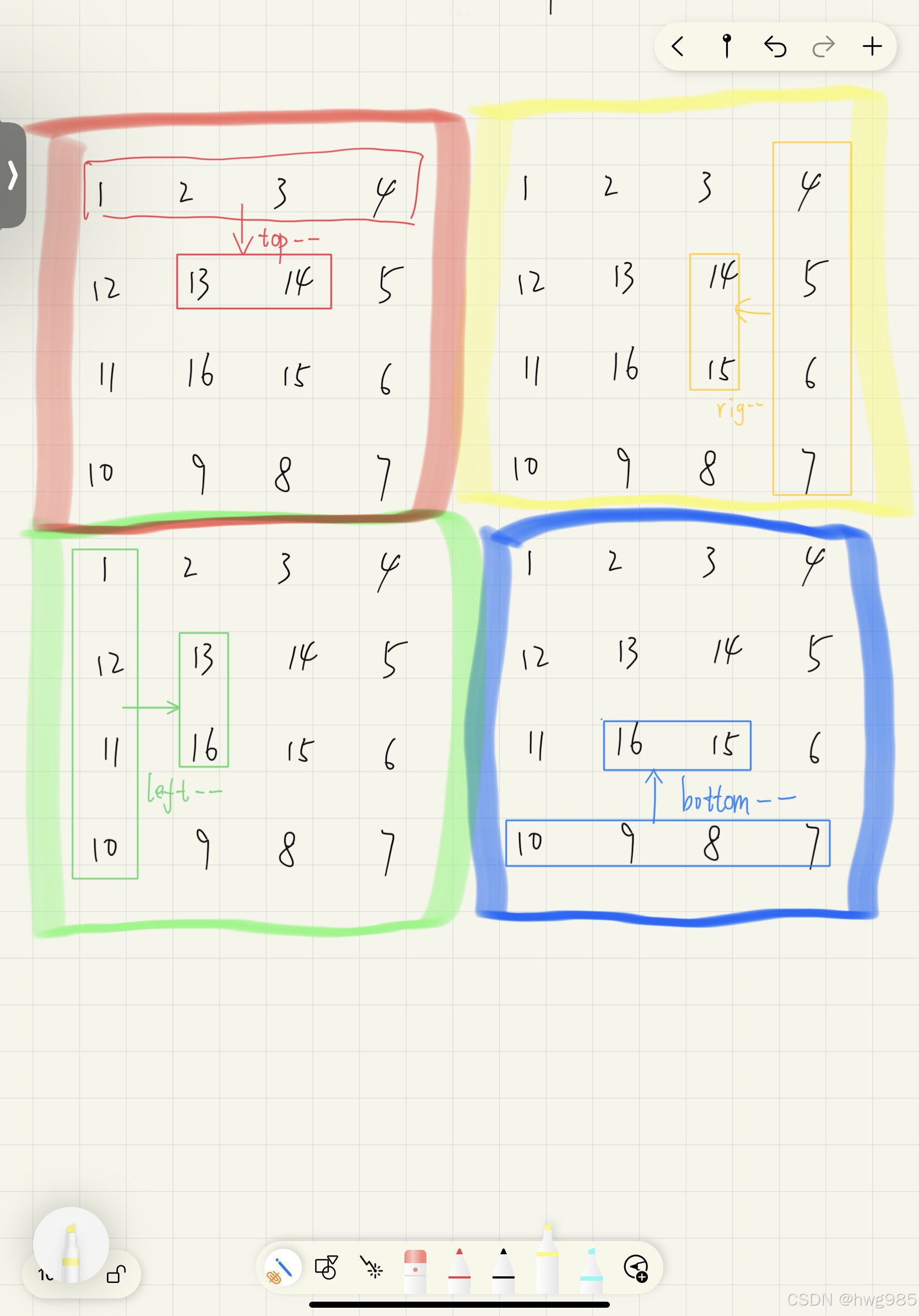文章目录
螺旋矩阵算法详解
题目描述
给你一个 m 行 n 列的矩阵 matrix,请按照 顺时针螺旋顺序 ,返回矩阵中的所有元素。
示例
输入:matrix = [[1,2,3],[4,5,6],[7,8,9]]
输出:[1,2,3,6,9,8,7,4,5]
可视化:
1 → 2 → 3
↓
4 → 5 6
↑ ↓
7 ← 8 ← 9
算法核心思想
关键概念:四边界控制
通过维护四个边界来控制遍历范围:
top:上边界bottom:下边界left:左边界right:右边界
遍历顺序
按照顺时针方向,循环执行四个步骤:
- 从左到右 遍历上边界
- 从上到下 遍历右边界
- 从右到左 遍历下边界
- 从下到上 遍历左边界
每完成一个方向的遍历,就收缩对应的边界。
算法实现
public List<Integer> spiralOrder(int[][] matrix) {
List<Integer> result = new ArrayList<>();
if (matrix.length == 0) return result;
// 定义四个边界
int top = 0; // 上边界
int bottom = matrix.length - 1; // 下边界
int left = 0; // 左边界
int right = matrix[0].length - 1; // 右边界
while (top <= bottom && left <= right) {
// 1. 从左到右遍历上边界
for (int col = left; col <= right; col++) {
result.add(matrix[top][col]);
}
top++; // 上边界下移
// 2. 从上到下遍历右边界
for (int row = top; row <= bottom; row++) {
result.add(matrix[row][right]);
}
right--; // 右边界左移
// 3. 从右到左遍历下边界(需要检查是否还有行)
if (top <= bottom) {
for (int col = right; col >= left; col--) {
result.add(matrix[bottom][col]);
}
bottom--; // 下边界上移
}
// 4. 从下到上遍历左边界(需要检查是否还有列)
if (left <= right) {
for (int row = bottom; row >= top; row--) {
result.add(matrix[row][left]);
}
left++; // 左边界右移
}
}
return result;
}
算法步骤详解
示例:3x3矩阵 [[1,2,3],[4,5,6],[7,8,9]]
| 步骤 | 操作 | 遍历元素 | 边界变化 | 边界状态 |
|---|---|---|---|---|
| 初始 | - | - | - | top=0, bottom=2, left=0, right=2 |
| 1 | 左→右(上边界) | 1,2,3 | top++ | top=1, bottom=2, left=0, right=2 |
| 2 | 上→下(右边界) | 6,9 | right– | top=1, bottom=2, left=0, right=1 |
| 3 | 右→左(下边界) | 8,7 | bottom– | top=1, bottom=1, left=0, right=1 |
| 4 | 下→上(左边界) | 4 | left++ | top=1, bottom=1, left=1, right=1 |
| 5 | 左→右(上边界) | 5 | top++ | top=2, bottom=1, left=1, right=1 |
| 结束 | top > bottom | - | - | 循环结束 |
最终结果:[1,2,3,6,9,8,7,4,5]
边界处理的关键点
1. 为什么步骤3和4需要额外判断?
// 步骤3:从右到左遍历下边界
if (top <= bottom) { // 检查是否还有行
for (int col = right; col >= left; col--) {
result.add(matrix[bottom][col]);
}
bottom--;
}
// 步骤4:从下到上遍历左边界
if (left <= right) { // 检查是否还有列
for (int row = bottom; row >= top; row--) {
result.add(matrix[row][left]);
}
left++;
}
原因:避免重复遍历
2. 边界情况分析
单行矩阵:[[1,2,3,4,5]]
步骤1:1,2,3,4,5 (left→right)
步骤2:无元素 (top=1, bottom=0, 不满足top<=bottom)
结果:[1,2,3,4,5] ✅
单列矩阵:[[1],[2],[3]]
步骤1:1 (left→right)
步骤2:2,3 (top→bottom)
步骤3:跳过 (top>bottom)
步骤4:跳过 (left>right)
结果:[1,2,3] ✅
2x2矩阵:[[1,2],[3,4]]
步骤1:1,2 (top=0→1)
步骤2:4 (right=1→0)
步骤3:3 (bottom=1→0, 满足top<=bottom)
步骤4:跳过 (left>right)
结果:[1,2,4,3] ✅
可视化理解
边界收缩过程
初始状态:
top=0 ┌─────────┐
left=0 → │ 1 2 3 │ ← right=2
│ 4 5 6 │
│ 7 8 9 │
└─────────┘
bottom=2
第1步后:
top=1 ┌─────────┐
left=0 → │ █ █ █ │
│ 4 5 6 │ ← right=2
│ 7 8 9 │
└─────────┘
bottom=2
第2步后:
top=1 ┌─────────┐
left=0 → │ █ █ █ │
│ 4 5 █ │ ← right=1
│ 7 8 █ │
└─────────┘
bottom=2
第3步后:
top=1 ┌─────────┐
left=0 → │ █ █ █ │
│ 4 5 █ │ ← right=1
│ █ █ █ │
└─────────┘
bottom=1
第4步后:
top=1 ┌─────────┐
left=1 → │ █ █ █ │
│ █ 5 █ │ ← right=1
│ █ █ █ │
└─────────┘
bottom=1

复杂度分析
- 时间复杂度:O(m×n)
- 每个元素恰好被访问一次
- 空间复杂度:O(1)
- 只使用了常数个变量,不考虑结果数组
常见错误
1. 忘记边界检查
// 错误:可能重复遍历
for (int col = right; col >= left; col--) {
result.add(matrix[bottom][col]);
}
// 正确:需要检查
if (top <= bottom) {
for (int col = right; col >= left; col--) {
result.add(matrix[bottom][col]);
}
}
2. 边界更新顺序错误
// 错误:先更新边界再遍历
top++;
for (int col = left; col <= right; col++) {
result.add(matrix[top][col]);
}
// 正确:先遍历再更新边界
for (int col = left; col <= right; col++) {
result.add(matrix[top][col]);
}
top++;
总结
螺旋矩阵算法的核心是:
- 四边界控制:top、bottom、left、right
- 顺时针遍历:右→下→左→上
- 边界收缩:每完成一个方向就收缩对应边界
- 重复检查:避免在单行/单列情况下重复遍历
这是一个非常经典的模拟算法,考察边界处理和循环控制能力!